332 Terrier movement
MOVEMENT IN TERRIERS
by David Hancock
 A jaunty carriage, a blur of legs moving at high speed and a perky determination from a small dog in the show ring often brings unwarranted admiration -- unfailingly from the fawning uncritical TV commentators at Crufts. Most very small pedigree breeds that I see in the show ring display poor movement, usually stepping short in front with little forward reach and lacking any power from their lower hind quarters. Once judges regard and then accept such limited movement as characteristic then an inbred fault is on the way to becoming sealed in the gene-pool. That is very bad news for small dogs.
A jaunty carriage, a blur of legs moving at high speed and a perky determination from a small dog in the show ring often brings unwarranted admiration -- unfailingly from the fawning uncritical TV commentators at Crufts. Most very small pedigree breeds that I see in the show ring display poor movement, usually stepping short in front with little forward reach and lacking any power from their lower hind quarters. Once judges regard and then accept such limited movement as characteristic then an inbred fault is on the way to becoming sealed in the gene-pool. That is very bad news for small dogs.
I can understand, without supporting, poor movement in Toy breeds being condoned, so many have anatomical designs which create such an undesirable manifestation, but unsound movement in small terriers is worrying. These are sporting breeds. The sporting terrier is part of Britain's great sporting heritage and even the smallest of them must be a real terrier, in build and in attitude. Exhibits from any sporting breed should be disqualified in the ring for poor movement.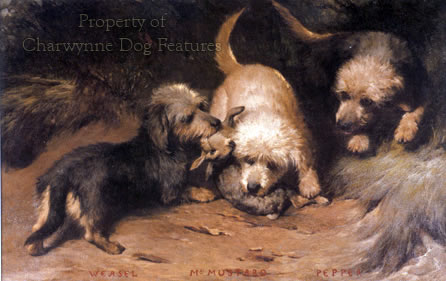
But what are show judges saying about movement in the terrier breeds in their critiques? Here are some from 1997: Border Terriers -- "Movement is still a problem..."; Border Terriers (at Crufts) -- "Sadly, movement left much to be desired..."; Dandie Dinmont Terriers -- "Hind movement in some was very bad..."; and from Crufts 2000-Airedale Terriers: "Movement is shocking...";-Kerry Blue Terriers: "Two main faults appeared...and rear movement";-Sealyham Terriers: "I found...bad hind movement." The four Crufts reports are the most worrying, for how do exhibits which display poor movement actually qualify? Who would want to breed from such dogs?
Who are the allegedly skilled breeders, breeding to the standard, who are producing these dogs with such unsatisfactory movement? Are they judges as well? The Border Terrier is expected to have movement sound enough to accompany mounted huntsmen. The Dandie Dinmont Terrier is expected to have a fluent, free and easy stride. For these two breeds of sporting terrier to have even disappointing movement is a poor commentary on some contemporary breeders.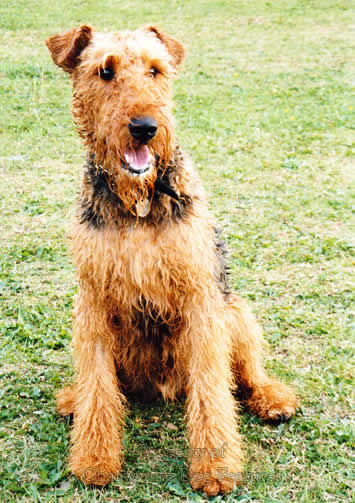
If you accept that movement is a manifestation of sound anatomy, why are poor movers not thrown out of the ring? When I watch the judging at working terrier shows, I still see weak pasterns, turned out toes and loose elbows up front, and cow hocks, bowed hocks, and too close or too wide a hind action. Poor shoulder placement and straight stifles and hocks are the cause of much poor movement in working terriers. Such functional dogs should move 'as square as a box', as the great terrier man OT Price would have put it. This means an action that is free, with appreciable but not long strides, parallel at both ends--showing the pads of the hind feet, with obvious drive from the hocks, a level topline--retained on the move, with the tail on top, a determined carriage of the head and a definite air of bossiness. 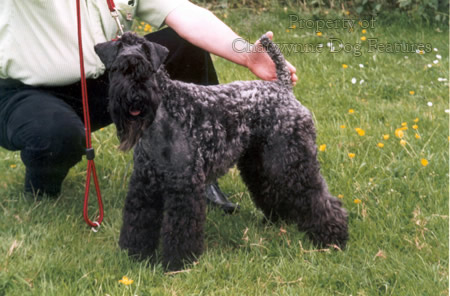
What I find especially baffling at dog shows is how dogs are awarded tickets when they breach their own breed standard, whoever has approved it. If you examine the wording of the KC breed standard of the smaller terriers on movement you find highly commendable wording. The Cairn is expected to have "Very free-flowing stride. Forelegs reaching well forward." The Dandie Dinmont is required to have "a fluent free and easy stride, reaching forward at the front" with a stilted gait highly undesirable. The Glen of Imaal has to be free in action. The Scottie has to have a smooth and free movement. The Skye's whole movement is termed free and active. The Westie's must be free with the front legs freely extended forward from the shoulder. So far, so good.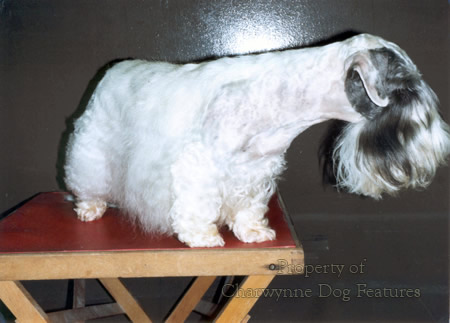
If you then spend time studying these breeds in the ring, what do you find? I see them, almost invariably, with short upper arms and upright shoulders which limit their reach and give them a fast, chopping, stilted, abbreviated front action with nothing free about it. And they win! And they win at Crufts! The profusion of coat in some of them gives the illusion of their flowing over the ground -- but then so too do millipedes. The extent of a dog's front stride is controlled by the length of its upper arm and the angulation or slope of its shoulders. The too-fast, short-reaching, chopping action of so many small terriers in the ring has almost become the norm. A good judge would notice that there is nothing free about such an action; the dog has to take two or three steps when one should do. Not surprisingly this affects hind action too. 
The late Tom Horner, who knew a thing or two about terrier movement, has written on this subject: "If the upper arm is short and/or steep, the angle between it and the shoulder blade will be much greater -- more open than the desired 90 degrees -- with the result that the elbow will be brought forward on the chest and the possible length of stride of the foreleg will be reduced. If shoulders are also steep the angle will be greater still and the stride even shorter." Small terriers with a shortened front stride are now almost the uniform exhibit in our show rings. It is extremely tiresome when this draws admiration from ignorant TV commentators at Crufts, who describe them as "simply flowing over the ground", perhaps because they can't walk naturally!
When a dog's shoulders are too upright they tend also to be narrower, shorter and bunch the muscles, giving a coarse look. This in turn shortens the neck and artificially lengthens the back, producing an unbalanced dog. Breeds like the Skye and the Dandie are now longer in the back and shorter in the leg than their ancestors. Working hunt terriers are usually a little longer backed than their show ring opposite numbers but for a good reason, the long, sloping shoulder tending to accompany the slightly longer back, with the pursuit of a cobby terrier, with the shorter back, encouraging the more upright shoulder. Dogs required to work underground need flexible backs so that they can work in confined spaces. Most of the show Fox Terriers would have some difficulty manoevring underground because of the construction now apparently sought in them.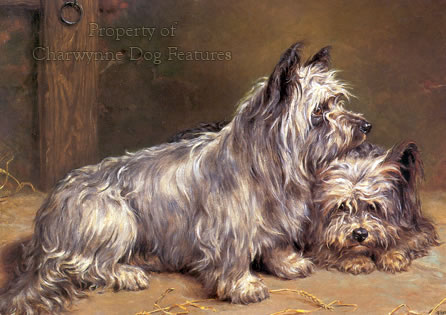
In his book "About the Border Terrier", Walter Gardner has written: "The well-laid on shoulder allows for great range and liberty of movement. On the other hand, when the shoulder blade is lacking in correct obliquity and is too upright, it usually lacks the desired length and therefore muscle attachment. The movement is therefore contracted, and the action short, cramped and lacking in elasticity." It is this short, cramped, restricted forward movement which so many small breeds demonstrate in the ring -- and get rewarded for! Walter Gardner goes on to state: "..it is unfortunate that many of those who are judging dogs have never had the opportunity to judge any other type of stock." Certainly, working horses are often stocky in build but display superbly placed shoulders. This feature is prized in the horse show ring. So many of the pioneer judges at dog shows were pony judges too.
We may not want our small terriers to move like ponies but we should try to ensure that they are able to lead active lives. A tiny Norwich, a sturdy Scottie, a cocky Cairn or a jaunty Jack Russell should, each in their own way, move soundly. It is not in the best interests of such dogs for them to be allowed to get away with poor movement or be judged as if sound movement didn't matter at all. Long standing faults in Dachshunds have been short necks, upright shoulders and loose elbows. Not surprisingly movement in the breed has long been a weak spot. The high head carriage helps this breed, but it has to take an awful lot of steps to get anywhere.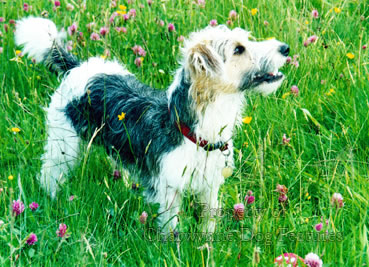
Unless the head is carried high, the appropriate muscles will not be able to pull the upper arm and then the whole foreleg forward to its full extent. Judges need to watch a dog moving across and then towards them and establish that the two forelegs are being brought well forward from the shoulders and the elbows. Any dog that 'marks time' is incorrectly constructed. Insufficient angulation between the pelvis and the spine, high placed hocks and straight stifles contribute to a short back stride and can be detected from a stilted action. But if that stilted action is actually admired, the fault is surely condoned. A canny judge will ask for small dogs to be moved slowly so that the true quality of the gait can be revealed. Just as the flying trot conceals a multitude of sins in the German Shepherd Dog, so too does the blurred too-hasty millipede-like leg movement in little dogs with little legs.
Small dogs with small bones, just as much as bigger heavier dogs, need sound construction to lead a healthy happy life. 'Stepping short' on the parade ground is a deliberately artificial movement and a surprisingly tiring one; stepping short in the show ring too should be regarded as artificial, unnatural and undesired. All dogs can only move with the construction bestowed upon them by their designers and breeders. But I suspect, with some sadness, that breeders will continue to do their own thing whatever the effect on the dog. 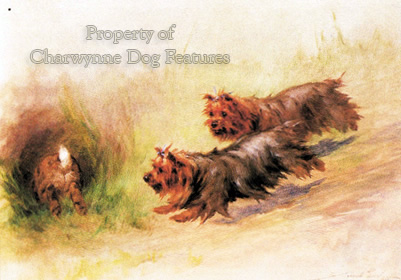
In an emergent breed, like the Sporting Lucas Terrier, breeders have a one-shot opportunity to breed working terriers which could be envied the world over; others are departing from soundness, now is the time to breed for the breed and not the wallet, establish the basis of a breed which respects its own breed standard but ensure that dogs lacking working instincts are not bred from. Any fool can breed charming little dogs, which resemble tail-less squirrels or white-coated Yorkies fit only for the bed-warming role. Breeding a working terrier is surely a joyful challenge: does it want to work? does it have the anatomy which allows it to work? Will those who come after us respect our work?
We live in times which threaten the very future of our sporting breeds. This means that without a loyal, well-intentioned, selfless, honourable band of breed fanciers to safeguard its future, many a breed will go to the wall. Sporting breeds will only survive because their survival is planned--and their ability to move soundly is ensured.